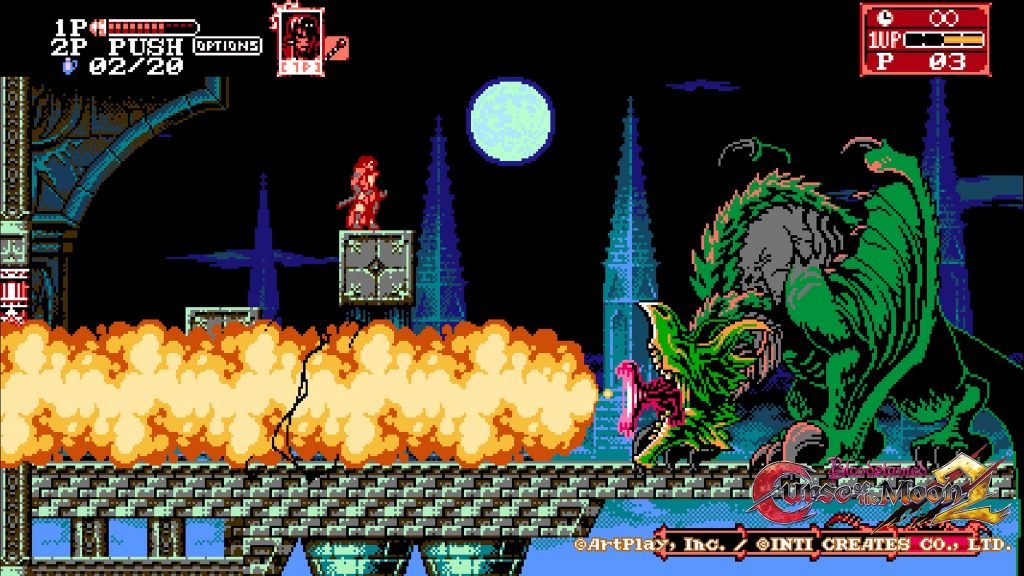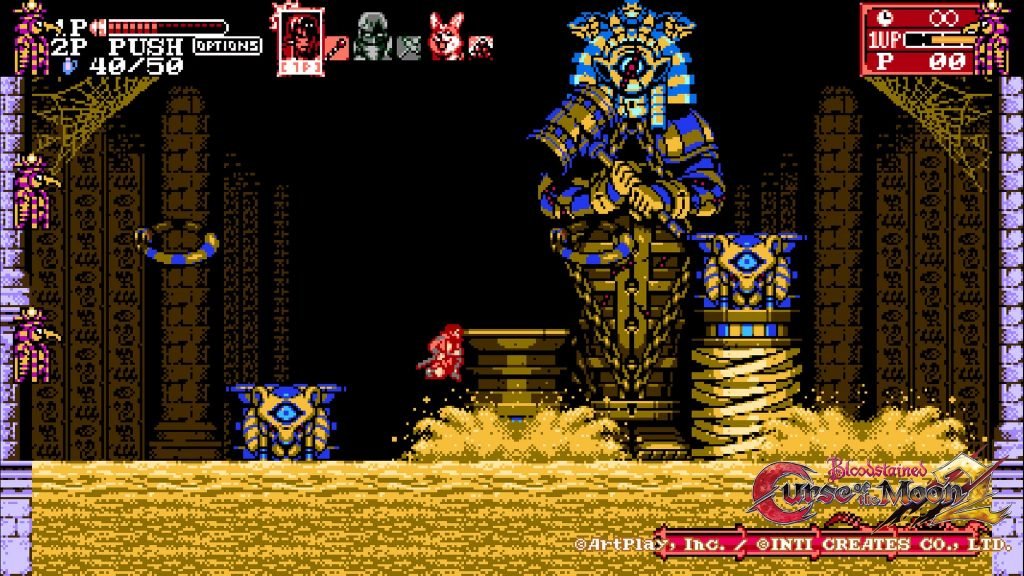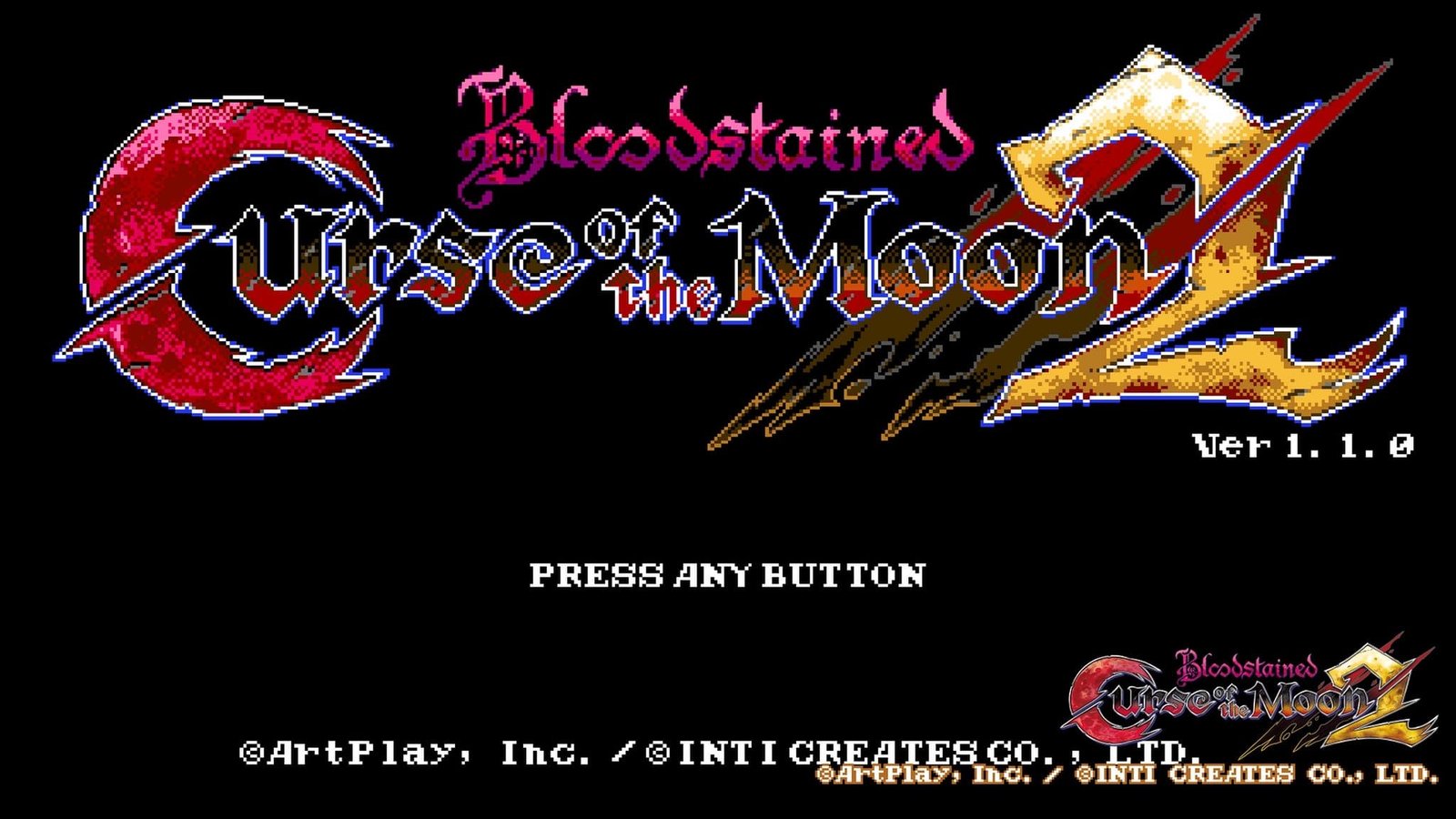Quick View:
Release Date: July 10, 2020
Price: $14.99
Rating: T (Teen)
Platform: PS4 (reviewed), Xbox One, Nintendo Switch, Steam

What's It About?
Bloodstained: Curse of the Moon is a spin-off series of Bloodstained: Ritual of the Night. Set in an alternate timeline and made in the style of an 8-bit game, 2018’s Curse of the Moon’s development was a stretch goal for Ritual’s ultra-successful Kickstarter campaign. The bite-sized homage to Castlevania III: Dracula’s Curse became an instant cult favorite, and now developer Inti Creates has created an even bigger and more ambitious sequel in Curse of the Moon 2.
The katana-wielding demon hunter Zangetsu (a supporting character from Ritual) is once again the primary protagonist, but his three companions from the original Curse are replaced with a new trio of warriors. The story features plenty of familiar faces from Ritual, but has some fun with its “What if?” alternate timeline to provide some fun surprises and easter eggs for those returning to the series.

The Good
Curse of the Moon 2 gives a wonderful first impression. After a short prologue, we cut to Zangetsu hang gliding across a gloomy night sky, past multiple castle spires that are brilliantly separated by layers of parallax scrolling, before landing atop one of the castle’s battlements. A card flashes across the screen with an evocative stage title, “The Dragon’s Silhouette,” and a darkly driving musical track begins to play. It’s quite a way to begin a game, and Curse 2 is nothing if not consistent with its amazing presentation.
The graphics pay homage to the 8-bit NES Castlevania trilogy, but that doesn’t mean that they’re not without some modern flourishes. Character sprites animate fluidly, backgrounds are highly detailed, and bosses are large and imposing. In fact, I’d go so far as to say that the promise of seeing the gigantic, creatively-designed boss creatures is a major motivation for playing through each of the game’s stages.
Music has always been a huge part of the Castlevania series’ appeal, and like its predecessor, Curse 2’s chiptune soundtrack is a thing of beauty. Whether it’s a slow and sinister beat or hard-driving metal, each track is completely unique and fits the stage it accompanies perfectly, and at least a couple are guaranteed to be stuck in your head for a long while after playing. As a whole, the soundtrack might not be quite as catchy as in the original’s, but it’s still undeniably one of the game’s biggest strengths.

Gameplay is as tight and responsive as you’d expect from a throwback to Castlevania, though I should point out the very subjective drawback of jumps being as rigid as they were in those 8-bit titles. Platforming requires precision, and can be utterly unforgiving when combined with the knockback your character suffers when hit by an enemy on “veteran” (default) difficulty. That being said, you are almost always given the ability best-suited for a situation at the right time via breakable lanterns. You can also obtain permanent stat power-ups hidden throughout each level.
Each of the game’s main four characters has his or her own strengths and weaknesses, but you can switch between characters quickly and freely. Zangetsu has high attack power, but a short jump; Dominique has low health, but a high jump and the attack length; Robert can shoot across the screen with his rifle but can only sustain a couple of attacks; and Hachi – sweet, adorable Hachi – is strong and can hover, but presents himself as a massive target.

The Bad
This game is difficult – sometimes to a maddening degree. I’m all for an “old school” challenge, and often seek out games specifically after hearing about how difficult they are, but I feel like Curse 2 goes a bit overboard with two or three bosses. Take the stage 6 boss for example, which is a building-sized sarcophagus that relentlessly bombards you with lightning and electric orbs while you attempt to dodge arrow traps and navigate moving platforms. It’s a lot to handle at once – especially if your strategy revolves around one character.
The game is split into three main episodes (along with an “extra” episode), but the vast majority of everything after episode one is made up of recycled content. You go through the same levels with increased difficulty, though you are often able to use routes that were inaccessible the first time through. Bosses’ attacks are sped up and they inflict more damage, so prepare for massive frustration with any that gave you a difficult time in episode one.

The Ugly
Curse 2 feels like a throwback to the NES era in all of the right ways… and one or two of the wrong ways as well, unfortunately. Each of the game’s eight sprawling stages has a handful of checkpoints scattered about, which you start back at after losing a life (all characters have died). If you die while still having a backup character available, you typically only go back one or two “screens,” which while seemingly generous, doesn’t take into account how essential certain characters’ abilities are in particular situations.
The checkpoint situation becomes exponentially worse when you are stuck on a difficult boss. If the character you are currently playing as runs out of health before you can switch to another, you don’t go back very far, but your remaining characters’ health is not restored whatsoever. You’ll often get back to the boss for a second (or third, or fourth) attempt with very little health and drop dead before you can figure out an effective strategy. The fact that the last checkpoint of each stage tends to be a ways before the boss room makes failure feel unnecessarily punishing.

Final Thoughts
Bloodstained: Curse of the Moon 2 is a very worthy sequel. The new characters are fun to play as and the level design complements their unique abilities. The game looks and sounds as good as it plays, with stunning retro-inspired graphics and a killer soundtrack. As much as I want to give it an unqualified recommendation, however, the occasionally overwhelming difficulty holds me back.
Those accustomed to the difficulty of the NES-era Castlevania games will likely be able to endure the difficulty and have an amazing time guiding Zangetsu on his quest to defeat his demonic nemeses. Those who are easily frustrated will likely find the experience to be overly-punishing, but it is also extremely rewarding, with some great surprises toward the end of the game. There are thankfully multiple difficulty options, and the game is worth experiencing for the presentation alone.
So grab your katana and prepare to cleave the blood moon in twain. Just be prepared to stumble a little along the way.

